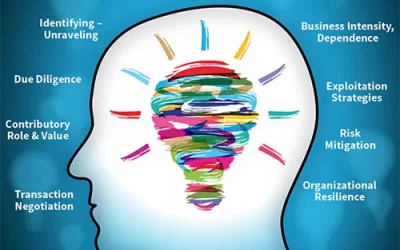Michael D. Moberly October 22, 2009
There’s little question that intellectual property (IP) and intangible assets are now key, foundational tenents for successful business management, primarily because both IP and intangible assets can, if stewarded and overseen effectively, become potential sources of substantial/domiant (company) value, revenue, sustainability, profit, growth, and competitive advantage.
To be sure, management teams, boards, and D&O’s who still consider IP and intangibles as merely constituting service functions and/or cost centers are well behind ‘the curve’ especially when most (prospective) investors view the presence and quality of a company’s IP and intangible asset strategy to be crucial enhancers of (a.) profit, (b.) share price, (c.) market position, and (d.) competitive advantage. In fact, most respondents to the Howery Survey of Investor Attitudes on IP Protection assert that company’s that lack an effective IP (intangible asset) strategy can have a detrimental effect on company performance.
In today’s increasingly know-how based business environment (economy) in which IP and intangibles are conservatively comprising 65+% of most company’s value, investors and financial analysts are giving much more weight to IP (and intangibles) when making their invest – don’t invest decisions. In fact, one in four of the Howery Survey respondents state they have actually turned down investment opportunities due to a company’s inadequate approach to IP. Fully 95% of the Howery survey respondents report that it is no longer sufficient, in the context of their investment decision, for a target company to merely own IP with no (aligned, integrated) protection, managerial, or competitive advantage peripheals.
Instead, the Howrey survey respondents believe, in substantial numbers, that before a favorable investment decision is made, the target company must have specific strategies (best practices) in place to not only exploit those assets, but also, have an IP and intangible asset protection program aligned with the target company’s competitive strategies.
The proverbial bottom line (in conjunction with the Howery Survey’s findings) is this; companies that presume, solely, that conventional IP enforcement protections are adequate to attract investors are finding instead, they’re no longer sufficient (standing alone) to favorably satisfy prospective investor demands vis-a-vis their investment decision criteria. To consistently attract serious investors, companies should also have in place (a.) comprehensive and on-going strategies to effectively safeguard those assets to reflect todays increasingly aggressive, predatorial, and winner-take-all business transaction environment, and (b.) seamlessly integrate same into a viable competitive strategy for utilizing and exploiting those assets.
(Adapted by Michael D. Moberly from the work of Howery, Simon, Arnold & White’s Survey Of Investor Attitudes on IP Protection)



